 |
 |
|
 |
Minnesota hosts annual AASHTO conference |
 |
 |
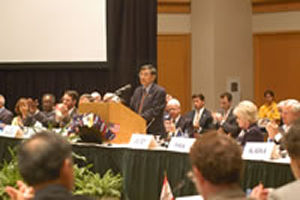 |
U.S. Secretary of Transportation Norman Mineta addressed a general
session of the AASHTO conference on Sunday, Sept. 7. Photo by Dave
Gonzalez
|
People from Mn/DOT joined representatives from state DOTs, the FHWA, consultants
and other industry members gathered to learn, share ideas and applaud
their achievements during the national meeting of the American Association of
State Highway and Transportation Officials in Sept. 4-9 in Minneapolis.
The meeting drew more than 1,000 participants from United States as well as
other nations.
Staff from Mn/DOT supported the conference, performing tasks that included
driving vans, registering participants, monitoring sessions, taking photos,
etc. Before the event, other Mn//DOT employees planned the event in cooperation
with AASHTO staff and management.
Comprised of members from the 50 states, the District of Columbia and Puerto
Rico and the transportation industry, AASHTO advocates transportation policies,
provides technical services and demonstrates the transportationís contributions
to the nation.
State and national leaders addressed the convention including Gov. Tim Pawlenty,
Lt. Gov./Commissioner Carol Molnau, U.S. Rep. Mark Kennedy of Minnesota and
Secretary of Transportation Norman Mineta. They stressed finding new solutions
to transportation problems
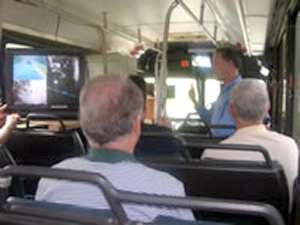 |
Craig Schankwitz, ITS Institute, U of M, explains the workings of the
Intelligent Vehicle Initiativeís SafePlow while on board the Metropolitan
Transit Commissionís TechnoBus. AASHTO conference participants could
observe the plowís operation via a video monitor in the TechnoBus as
the vehicles operated in tandem. Photo by Craig Wilkins
|
The participants met in workshops, small groups and assemblies to conduct AASHTO
business, present papers and visit an industry trade show held in conjunction
with the conference at the Minneapolis Convention Center.
Issues examined during the conference included transportation security, the
use of context-sensitive design, options to increase highway capacity and ways
to include environmental concerns in the very first stages of project planning.
Participants said the event enabled them to see issues from different perspectives
and widened their awareness of issues that Minnesota and other northern tier
states face when building and maintaining transportation systems.
They also toured facilities at the 3M Corporation in Maplewood to observe reflective
road marking fabrication and the Minnesota Road Research facility near Monticello
that uses a section of I-94 as a "real time" laboratory to test pavement
design and structure.
Another tour enabled conference participants to ride on the Metro Transit Commissionís
"TechnoBus." The bus uses global positioning system guidance, radar
and other tools to help drivers stay within the narrow confines of highway shoulders
they use during peak traffic periods. The bus operated in tandem with the Intelligent
Vehicle Initiativeís SafePlow to allow visitors to see the plowís operation
via live video from the truck shown on the bus. The demonstration was held on
the busway that connects the Minneapolis and St. Paul campuses of the University
of Minnesota.
 |
Anna Cady, Kay McDonald and Ron McLane, Information Technology, solved
a printer problem for support staff at the conference.
Photo by Judy Melander
|
Al Brantley, a MissDOT official, joked that he couldnít wait to transfer advanced
snowplow technology to his state, but Brantley and others from the southern
states said they use or could use similar technology to manage operations during
the hurricanes and other severe storms that plague Mississippi, Louisiana and
other coastal states.
Mn/DOT received AASHTOís Legacy Award for preserving the history of Hwy 100
in the western Minneapolis suburbs during its reconstruction.
Hosting the conference enabled transportation professionals from the region
to attend and generated about $2 million in associated revenue for Twin Cities
area businesses as well.
By Craig Wilkins
|
back

|
 |
Highway Helper program goes FIRST |
 |
 |
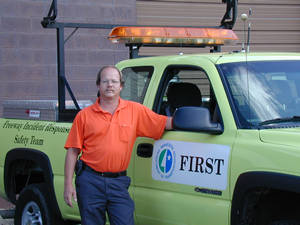 |
John Lardy, a member of the FIRST team based at Metroís Cedar Avenue
Truck Station, shows the new truck logo. Photo by Craig Wilkins
|
Mn/DOT recently changed the name of the Highway Helper program to the Freeway
Incident Response Safety Team to better reflect its role in managing congestion
and incident response on the Twin Cities metro regionís highway network.
"There is a misperception that the Highway Helper program is about helping
individual motoristsónot about improving safety and reducing congestion on our
highway system," said Lt. Gov./Commissioner Carol Molnau. "The name
FIRST better describes the programís role in responding quickly to remove congestion-causing
problems."
Molnau said the FIRST program is an important element of Mn/DOTís overall incident
management plan.
"If we cannot quickly respond to lane-blocking stalls or pick up debris
within minutes of its falling from a trailer, our highway system will break
down causing congestion, unexpected delays to motorists and secondary crashes,"
she said.
FIRST staff will continue to provide emergency aid to motorists as needed.
Each bright yellow-green truck carries a portable message sign to support emergency
traffic control and uses heavy push bumpers to move stalled or damaged vehicles
to clear shoulders and traffic lanes quickly.
By Craig Wilkins
|
back

|
 |
Traffic monitors go airborne to expand Twin Citiesí highway coverage |
 |
 |
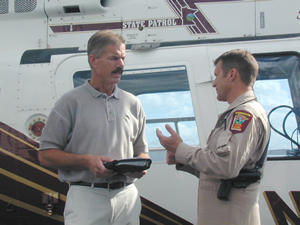 |
Tom Heininger, RTMC, and State Patrol pilot Capt. Mark Dunaski prepare
for a flight at the St. Paul Downtown Airport to cover afternoon traffic.
Photo by Craig Wilkins
|
To get a better look at Twin Cities traffic, the Regional Transportation Management
Center staff are getting a new angle on thingsófrom about 2,100 feet above the
ground.
Each work day, a staff member from the RTMC in Roseville flies with a State
Patrol pilot during the morning and evening rush hours to supplement the information
collected by the centerís system of traffic cameras, loop detectors and other
devices.
The aerial surveillance began Aug. 25. The FHWA gave $200,000 in funding to
Mn/DOT to conduct the program for one year.
The two-member teamsópilot and traffic observerófly in a fixed-wing aircraft
during the morning traffic peak and in a helicopter for the homebound traffic
rush.
Mary Meinert, RTMC, said fixed-wing aircraft allows the team to go out further
from the core cities of Minneapolis and St. Paul to observe in-bound traffic.
The helicopter provides a steady, lower-speed platform to monitor the evening
traffic.
The crews fly from 6:30 to 8:30 a.m. and from 3:30 to 6 p.m. Monday through
Friday.
Their higher vantage point gives the crews the ability to see beyond the limits
of the freeway systemís video monitors and observe traffic problems as soon
as they occur, giving them a chance to alert the RTMC staff. In addition to
the crewmembersí visual scans, the helicopterís infrared camera enables the
observers to monitor traffic through snow, clouds and darkness. A video camera
will be used on the fixed-wing aircraft as well.
Twin Cities area news media can also use the video feed from the aircraft via
a direct connection to the RTMC.
The observers send traffic condition information via the regional digital radio
system to the RTMC as developments occur.
"Essentially, the aerial patrols bring the entire Twin Cities metro area
into view," said Nick Thompson, freeway operations manager, RTMC. "Our
cameras cover only about 80 percent of the regionís freeways, so now we can
see places where we donít have cameras, where existing cameras arenít functioning
or on signalized highways such as Hwy 65 and Hwy 252 that are major traffic
corridors."
Thompson said the State Patrol uses the flights for law enforcement purposes,
and notes that RTMC staff have been involved in the response to a fatal crash
on Hwy 8 and other incidents.
"This is a partnership," he said. "Both law enforcement and
traffic monitoring are major components of traffic management to help make our
roads safer."
By Craig Wilkins
|
back

|
 |
History Channel show highlights Minnesotaís use of intelligent vehicles to improve
safety |
 |
 |
 |
Edelman Production film crew interviews John Scharffbillig (in truck)
about the use of GPS in the SafePlow. Photo by Sonia Pitt
|
On a very cold day last January, a film crew from Edelman Productions filmed
Mn/DOT and the State Patrol using global positioning systems to make Minnesota
roadways safer for snowplow drivers, state troopers and the public.
Their film footage aired Sept. 9 on the History Channelís Tactical to Practical,
a new 13-episode series highlighting technology that originated for military
use and evolved for use by the public. If you watched the first show, you may
have recognized a couple of faces.
John Scharffbillig, Mn/DOTís field project manager with Intelligent Transportation
Systems, and Jeff Goldsmith, a Minnesota state trooper, were included in the
GPS segment on Tactical to Practical.
Mn/DOT and the State Patrol partnered in a three-year project using Mn/DOTís
SafePlow and a Minnesota State Patrol vehicle equipped with technology using
GPS. The vehicles were tested along Hwy 7 from the Twin Cities to Hutchinson.
The technology allows the driver to "see" the roadway in a heads up
display during adverse weather conditions such as snow, fog and heavy rain.
Icons appear on the HUD to indicate oncoming traffic and other objects.
For more information, contact Scharffbillig at 651/215-0402.
By Sonia Pitt
|
back

|
 |
Design Camp kids present future of transportation |
 |
 |
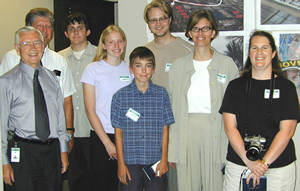 |
Design Camp participants had the opportunity to present one of their
innovative ideas for solving transportation problems to Mn/DOT senior
staff on Aug. 18. From left are Deputy Commissioner Doug Differt; Scott
Peterson, acting director, Finance; Griffin Johnson, Plymouth; Kathleen
Woodwick, Edina; Peter Durrant, Minneapolis; Ryan Siemers, University
of Minnesota; Katleen Harder, University of Minnesota; and Wendy Friedmeyer,
Design Camp coordinator. Photo by Donna Lindberg
|
Itís not every day that high school students have the opportunity to present
their solutions to transportation problems, but on Aug. 18 four of them got
to do just that before Mn/DOT senior staff.
The students were participants in Design Camp, a week-long program sponsored
by the University of Minnesota and Target Corporation that introduces high school
students to the design process and allows them to explore new ways to solve
problems, said Wendy Friedmeyer, Design Camp coordinator. They work under the
instruction of design professionals from around the world and the U of M.
The camp is divided into six workshops based on common behaviors, such as dwelling,
eating and moving. Students select a problem to solve, a design to improve or
a system to replace. They then explore the problems through discussion, field
trips to the Walker Art Center, drawing and modeling projects. At the end of
camp, students present their product to jurors from the local professional community.
Scott Peterson, acting director, Office of Finance, whose daughter Ellen participated
in the program this summer, was invited last June to tour the camp and see the
campersí designs.
"During my visit, I was so impressed by the imagination and thoughtful
problem solving of the ĎMoving Group,í I asked one of the instructors, Kathleen
Harder, if she would bring them to visit Mn/DOT and give a presentation on the
transit system they had designed," Peterson said.
"The Moving Group was asked how mass transit could be improved,"
said Friedmeyer. "They used models and computer graphics to display their
solution, which they demonstrated at Mn/DOT."
The Moving Groupís solution was Metro Magnetic Movement. This included a Segway
personal rapid transit device, a neighborhood bus and a train system above highway
medians.
Small buses would pick up commuters at home and drop them at train terminals.
Passengers could relax in the forward cars, eat in a diner, drink coffee or
read in a library until their stop. Then they would move to the last train car
that would be dropped off at the station. Other cars in the train would then
pick up a new full car without coming to a stop, moving uninterrupted to the
next station.
The train would be powered by an electric magnetic system and could handle
small housing units (also developed at Design Camp), Segways, and even freight.
The M3ís route could also easily be expanded by adding additional loops to the
cloverleaf shaped route.
"The Moving Group ideas were imaginative, innovative and well researched,"
said Donna Allan, director, Office of Transit. "With these kinds of young
minds at work, the future of transportation looks bright."
By Donna Lindberg
|
back

|
 |
Duluth District recognizes DNR for Hwy 61 partnership |
 |
 |
 |
Officials from Mn/DOT's Duluth/District 1 and the Department of Natural
Resources at Gooseberry State Park hold an FHWA award recognizing their
partnership in building a new Hwy 61 river crossing. From left to right:
Mike Hoops, assistant manager of Gooseberry Falls State Park; Jim Willford,
DNR regional park manager; Mike Robinson, Duluth/District 1 engineer;
Paul Sundberg, manager of Gooseberry Falls State Park, and Rod Garver,
Mn/DOT Hwy 61 corridor manager. Photo by John Bray
|
Mn/DOT Duluth/District 1 officials last month recognized the Department of
Natural Resources at Gooseberry State Park for their partnership
in the Hwy 61 Gooseberry River Crossing project.
The Hwy 61 project was one of 47 national winners in the recently announced
2002 FHWA Excellence in Highway Design Biennial Award Competition.
The project built a new bridge that replicates the historic original bridge
that was built in 1925. The project provides for a safer pedestrian-level under-crossing,
a new park entrance road, much-needed parking lots, a park visitor center, a
safety rest area, a pedestrian bridge, and handicapped-accessible trails to
the scenic Gooseberry Falls.
Along with Mn/DOT and the DNR, contractors M.A. Mortenson Co. of Minneapolis
and Northland Constructors of Duluth also received plaques recognizing their
roles in this project.
In the 2002 FHWA Biennial Awards national line-up of the "best of show,"
a total of 47 projects from throughout the nation received recognition. Of these,
Duluth/District 1 received four national awards for the following projects:
-
Hwy 61 Silver Creek Cliff Tunnel
-
Hwy 61 Gooseberry River Crossing
-
Hwy 61 Reconstruction in Schroeder
-
Hwy 33 Bridge over the St. Louis River in Cloquet
By John Bray
|
back

|
 |
|
 |



